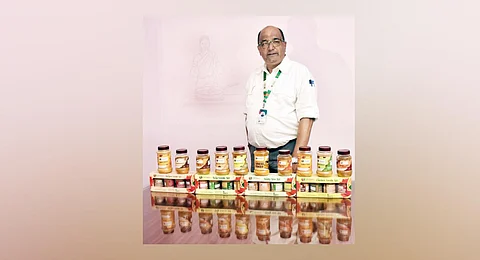

CHENNAI: Food can be medicine, and spices like garam masala, when utilised properly, can boost health, upregulate genes and cure diseases, asserts V Ganesh, the managing director of LifeSpice India Pvt Ltd. Spices contain phytochemicals (chemicals found in plants that protect plants against bacteria, viruses, and fungi) that can create optimal genetic performance and redeem disease targets, he explains.
According to the managing director, centuries ago, our ancestors had an array of tools to treat spices with respect and preserve phytochemicals, without additives like garlic or onion. “When did we migrate to buying spice mixes unaware of traditional health practices?...now, India consumes 100,0000 tonnes of market-made masala mixes pounded with ingredients like onion, and garlic. In search of better profits, the corporates have also turned to purchasing low-cost materials that lack the phytochemical potency of spices,” he says.
Taking a leaf from the book of our ancestors, LifeSpice aims to preserve phytochemicals and instead recommends adding ingredients like fresh onion or garlic directly to the curry. The city-based firm, incorporated in June 2020, aims to aid novice cooks who are encountering the kitchen for the first time and reduce the eight and half hours usually spent by women in these spices.
Spices are a major part of India’s history whether it is the spice route or Englishmen coming to occupy the nation under the banner of the East India Company. The red and green chilli is about 400-450 years old as a crop in the world. Black pepper, which was the original chilli of the world, was a bounty to pay from the losing kingdom to the other kingdom. They also have the power to heal.
Pandemic project
From WhatsApp to emails, long threads of messages filled with anxious questions and theories about health, symptoms of Covid-19, and news of countless people passing away during this time. Soon, Ganesh, too, began thinking of health. He realised the biggest contributor to deaths in the world were heart disease, cancer, lung disease and diabetes, and cholesterol.
By June 2020, Ganesh was on a mission to see if spices have the ability to reverse damage to the body. In hopes of “finding a solution for mankind”, he tracked down a sole proprietorship laboratory on the 630th page of Google to analyse how four home-ground mixes in optimum combinations could impact zebrafish. The team began researching each spice power and benefits they had, segregating ones linked with heart, self-physiology, or glucose lipid management.
By the end of the tests, it was proven to upregulate human genes and manage cancer and heart ailments with periodic consumption. The charts showed that the phytochemicals like oleanole, cineole, and anethole among others had spiked in the experiment group of fish, proving a parallel positive effect on humans.
Incorporated shortly the same year, LifeSpice began their journey of producing and marketing around 20 mix recipes including ‘Tea Masala for Lung Care’, ‘Veg Biryani Spice’, and ‘ Garam Masala for Diabetes and Cholesterol Care’. Instead, they urge customers to use fresh ingredients with their spices. Their mixes can reduce Lost Life Years (LLY) and Disability Adjusted Life Years (DALY).
Ingredient list
How many people look through the ingredients list of spices at the back of spice mixes? How many people know they potentially could harm their health? Ganesh urges consumers to check these labels.
Often, market mixes use chilli and coriander that have been hit by aflatoxins (toxins produced by fungi that are found on crops) as quality chilis are segregated and exported to other countries. “The white colour on chillis is a big indicator of aflatoxin. My question is who allows the industry to buy these white dried chilis with these toxins and sell them with FSSAI certification? This whole industry worth Rs 60,000 crore is making people gullible because of ignorance,” he details.
To weed out toxic ingredients and craft their mixes, the company set up a factory in Ranipet where quality everything is individually cleaned, fumigated, and roasted at appropriate temperatures and coarse ground. With the tagline ‘Re-imagining Cooking’, the bottles of these ground spices hit local supermarkets and e-commerce websites. For more details, visit: https://lifespice.co.in/